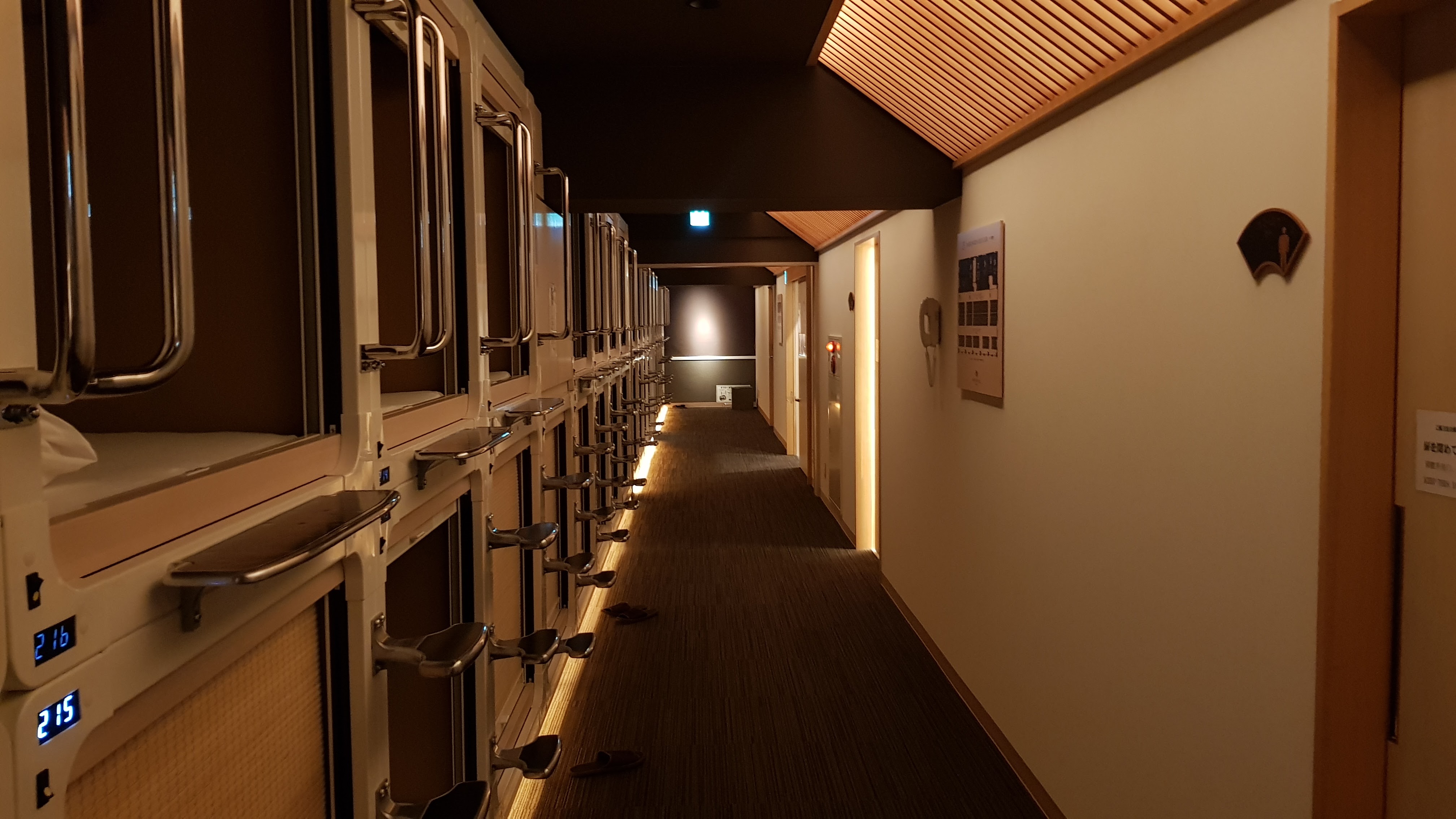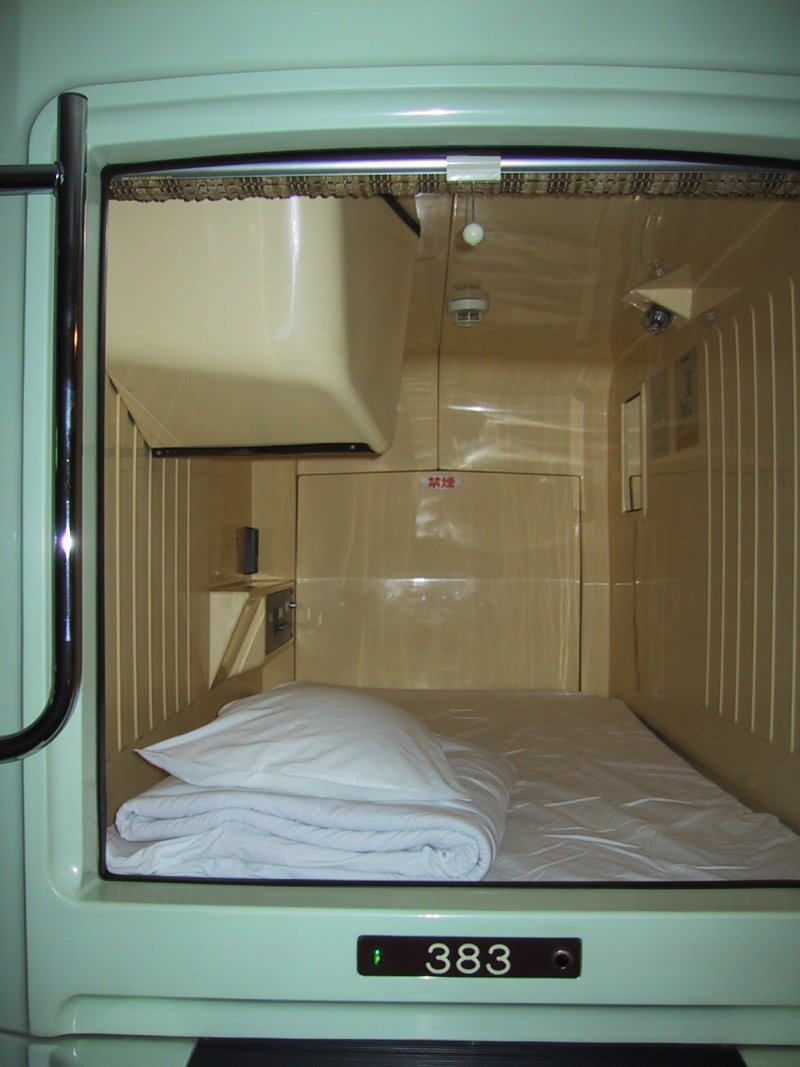Capsule Hotel on:
[Wikipedia]
[Google]
[Amazon]
 A capsule hotel (), also known in the
A capsule hotel (), also known in the
 Like a hostel, many amenities are communally shared, including
Like a hostel, many amenities are communally shared, including
"For Some in Japan, Home Is a Tiny Plastic Bunk"
''
A list of capsule hotels
{{DEFAULTSORT:Capsule Hotel Hotel types Hotels in Japan Homelessness Japanese inventions 1979 introductions 1979 establishments in Japan
 A capsule hotel (), also known in the
A capsule hotel (), also known in the Western world
The Western world, also known as the West, primarily refers to various nations and state (polity), states in Western Europe, Northern America, and Australasia; with some debate as to whether those in Eastern Europe and Latin America also const ...
as a pod hotel, is a type of hotel
A hotel is an establishment that provides paid lodging on a short-term basis. Facilities provided inside a hotel room may range from a modest-quality mattress in a small room to large suites with bigger, higher-quality beds, a dresser, a re ...
developed in Japan
Japan is an island country in East Asia. Located in the Pacific Ocean off the northeast coast of the Asia, Asian mainland, it is bordered on the west by the Sea of Japan and extends from the Sea of Okhotsk in the north to the East China Sea ...
that features many small, bed-sized rooms known as capsules. Capsule hotels provide cheap, basic overnight accommodation for guests who do not require or who cannot afford larger, more expensive rooms offered by more conventional hotels.
The first capsule hotel in the world opened in 1979 and was the Capsule Inn Osaka, located in the Umeda district of Osaka
is a Cities designated by government ordinance of Japan, designated city in the Kansai region of Honshu in Japan. It is the capital of and most populous city in Osaka Prefecture, and the List of cities in Japan, third-most populous city in J ...
, Japan and designed by Kisho Kurokawa. From there, it spread to other cities within Japan. Since then, the concept has further spread to various other territories, including Belgium, Canada, China, Hong Kong, Iceland, India, Indonesia, Israel, Poland, Saudi Arabia, and South Korea.
Description
The guest room is a chamber roughly the length and width of a single bed, with sufficient height for a hotel guest to crawl in and sit up on the bed. The chamber walls may be made of wood, metal or any rigid material, but are often fibreglass or plastic. Amenities within the room generally include a small television, air conditioning, an electronic console, and power sockets. The capsules are stacked side-by-side, two units high, with steps or ladders providing access to the second-level rooms, similar to bunk beds. The open end of the capsule can be closed with a curtain or a solid door for privacy, and can be locked from the inside only. Like a hostel, many amenities are communally shared, including
Like a hostel, many amenities are communally shared, including toilet
A toilet is a piece of sanitary hardware that collects human waste (urine and feces) and sometimes toilet paper, usually for disposal. Flush toilets use water, while dry or non-flush toilets do not. They can be designed for a sitting p ...
s, shower
A shower is a place in which a person bathes under a spray of typically warm or hot water. Indoors, there is a drain in the floor. Most showers are set up to have adjustable temperature, spray pressure and showerhead nozzle angle. The si ...
s, wireless internet, and dining rooms. In Japan, a capsule hotel may have a communal bath and sauna. Some hotels also provide restaurants, snack bars, bars, or vending machine
A vending machine is an automated machine that dispenses items such as snacks, beverages, cigarettes, and lottery tickets to consumers after cash, a credit card, or other forms of payment are inserted into the machine or payment is otherwise m ...
s, pools, and other entertainment facilities. There may be a lounge with upholstered chairs for relaxing, along with newspapers and reading material.
Capsule hotels vary in size, from 50 or so capsules to 700, and primarily cater to men. Some capsule hotels offer separate sections for male and female guests, or even separate floors and elevators. Clothes and shoes are exchanged for a '' yukata'' and slippers on entry, and a towel and bathrobe may also be provided. Luggage and valuables are usually stored in lockers or—if available—in-room safes. Guests are asked not to smoke or eat in the capsules.
Customer base
The benefits of these hotels are their convenience and low price, usually around ¥2000–4000 (USD –) a night. In Japan, capsule hotels have been stereotypically used by Japanese salarymen who may be too drunk to return home safely, have missed the last train of the day to make a return trip home due to working late hours, or are too embarrassed to face their spouses. During theGreat Recession
The Great Recession was a period of market decline in economies around the world that occurred from late 2007 to mid-2009.
, some unemployed or underemployed workers who had become homeless during the crisis temporarily rented capsules by the month. As of 2010, these customers made up 30% of visitors at the Capsule Hotel Shinjuku 510 in Tokyo
Tokyo, officially the Tokyo Metropolis, is the capital of Japan, capital and List of cities in Japan, most populous city in Japan. With a population of over 14 million in the city proper in 2023, it is List of largest cities, one of the most ...
. Tabuchi, Hiroko"For Some in Japan, Home Is a Tiny Plastic Bunk"
''
The New York Times
''The New York Times'' (''NYT'') is an American daily newspaper based in New York City. ''The New York Times'' covers domestic, national, and international news, and publishes opinion pieces, investigative reports, and reviews. As one of ...
'', 2010-01-01. Retrieved on 2010-01-18.
See also
* Sleepbox * Nap pod * Transit hotel * Bedspace apartment * Shipping container architecture * Flophouse * Four penny coffin * Nakagin Capsule TowerReferences
Further reading
*External links
A list of capsule hotels
{{DEFAULTSORT:Capsule Hotel Hotel types Hotels in Japan Homelessness Japanese inventions 1979 introductions 1979 establishments in Japan